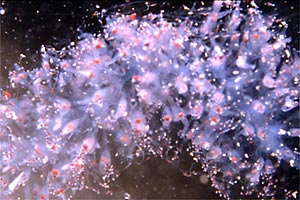
Zyzzyzus is a genus of marine tubulariid hydrozoans, which grow embedded in sponges.

Chrysaora is a genus of jellyfish, commonly called the sea nettles, in the family Pelagiidae. The origin of the genus name Chrysaora lies in Greek mythology with Chrysaor, brother of Pegasus and son of Poseidon and Medusa. Translated, Chrysaor means "he who has a golden armament."

Rhopalonematidae is a family of hydrozoans. The family comprises 15 genera and 36 species.

Turritopsis is a genus of hydrozoans in the family Oceaniidae.

Haleciidae is a family of hydrozoans. Their hydroid colonies emerge from a creeping hydrorhiza and usually form upright branching colonies, although some species' colonies are stolonal. Their gonophores are typically sporosacs, growing singly or bunched into a glomulus. They remain attached to the hydroids or break off to be passively drifted away; in a few, the gonophores are naked.
Csiromedusa medeopolis is a species of hydrozoan described in 2010. It was discovered in the estuarine waters of the River Derwent near to the Commonwealth Scientific and Industrial Research Organisation's Marine and Atmospheric Research branch in Hobart, Tasmania, Australia. C. medeopolis has been described as presenting a new family and genus as well as species.

Oceaniidae is one of the over 50 cnidarian families of the order Anthomedusae. It contains nearly 50 species in ten genera. Animals in the ocean that breath water. Partly Entirely New In Sea

Aequoreidae is a family of hydrozoans, sometimes called the many-ribbed jellies or many-ribbed jellyfish. There are approximately 30 known species found in temperate and tropical marine coastal environments. Aequoreids include Aequorea victoria, the organism from which the green fluorescent protein gene was isolated.
Solmarisidae is a family of hydrozoans in the order Narcomedusae. The name is sometimes spelled "Solmaridae".
Bougainvillia frondosa is a marine invertebrate, a species of hydroid in the suborder Anthomedusae. It was first described by Mayer in 1900.
Bougainvillia crassa is a marine invertebrate, a species of hydroid in the suborder Anthomedusae. It was first described by Frassa in 1938.

Solanderia is the sole genus of hydrozoans in the monotypic family Solanderiidae. They are commonly known as tree hydroids or sea fan hydroids.

Apolemia is a genus of siphonophores. It is the only genus in the monotypic family Apolemiidae.

Apolemia uvaria, commonly known as string jellyfish, barbed wire jellyfish, and long stringy stingy thingy, is a siphonophore in the family Apolemiidae.

Porpita prunella is a marine species of hydrozoan organisms within the family Porpitidae. It consists of colonies of zooids. Very little is known about this species, as there have been no confirmed sightings since its discovery in 1801 and naming by Haeckel in 1888. Being in the chondrophore group, it is likely that its behaviour is similar to the other species of the genera in the family. However there are also serious doubts as to its very existence as a separate species and may in fact be a synonym for Porpita porpita instead.

Aglantha is a genus of deep-sea hydrozoans of the family Rhopalonematidae.

Colobonema is a genus of deep-sea hydrozoans.
Amphogona is a genus of deep-sea hydrozoans of the family of Rhopalonematidae. It has a cosmopolitan distribution in tropical to temperate oceans.

Rhopalonema is a genus of deep-sea hydrozoans of the family Rhopalonematidae.
Paracoryne is a monotypic genus of cnidarians belonging to the monotypic family Paracorynidae.













